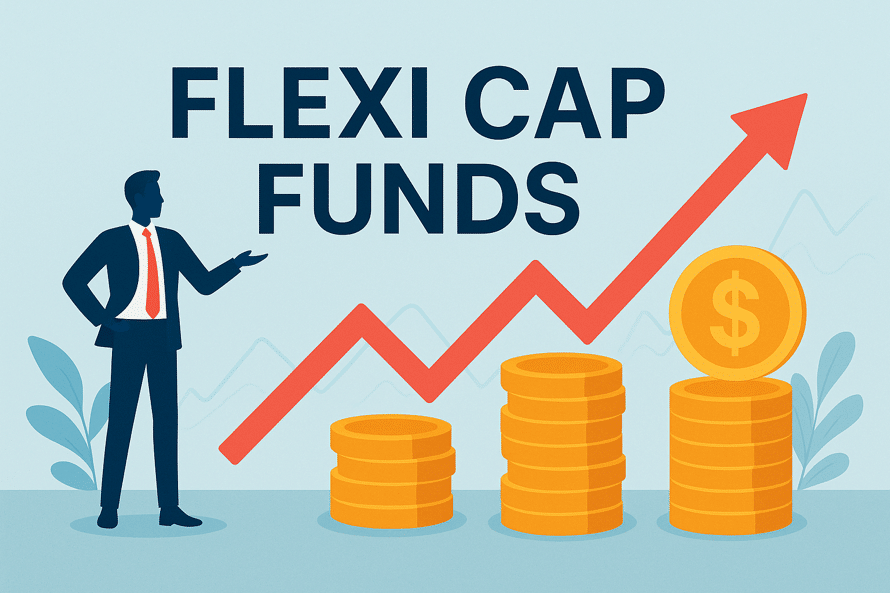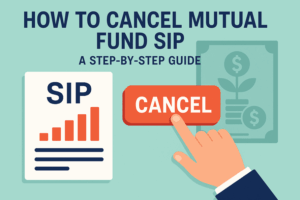SIP Calculator
×
Flexi Cap Funds: A Comprehensive Analysis for 2025

Investing in large-cap, mid-cap, and small-cap stocks is made possible through flexi-cap mutual funds. These funds are not limited to specific market capitalization, unlike category-specific funds. If you want to learn more about flexi-cap mutual funds and how flexi-cap funds work, keep reading!
Introduction to Flexi Cap Funds and Their Investment Scope
When the market is unstable, and you want to lower your risk, you tend to invest your money in segments that perform well. Imagine a joint fund that allows people to invest in any of these companies, regardless of their size, based on where the best growth opportunities are.
What Are Flexi Cap Funds?
You can invest in any market capitalization category of stocks with flexi cap funds. These are open-ended equity mutual funds that can invest in stocks of small, medium, or large companies. It gives fund managers the freedom to buy stocks in any of these companies, even ones that aren’t in the same industry or have the same market value.
“Start investing with confidence! Explore the best
mutual funds
and grow your wealth.”
Understanding the Structure of Flexi Cap Funds
A flexi-cap fund is a type of mutual fund that can invest in businesses of any market capitalization. The prospectus of the fund will reflect this arrangement. A firm’s size has less bearing on flexi-cap funds than it does on mid-cap or small-cap funds.
Why Investors Are Opting for Flexi Cap Funds
Flexi-cap funds are popular among most investors, offering reduced risk and development opportunities. It lets investors distribute their funds across small, mid-cap, and large-cap enterprises. This implies that by selling underperforming equities, investors minimize risk and still earn superior profits from the top-performing stocks.
Key Features and Benefits of Flexi Cap Funds
Flexi cap funds allow fund managers to invest in stocks across all three market capitalizations, making them a flexible way to allocate investments. This makes the portfolio more diverse, lowers risk, and helps increase returns.
Investment Flexibility across Market Caps
Flexi-cap funds are popular with investors as they offer a wide range of stock choices. Besides, it gives fund managers the flexibility to allocate funds across different market capitalizations and sectors according to changing market conditions.
Active Management and Dynamic Allocation
Fund managers choose stocks after doing careful research and analyzing the market. They ensure that assets are allocated effectively. They keep a close eye on the market and the economy’s overall direction, making changes as needed to generate positive returns.
Potential for Higher Returns in Changing Markets
Flexi-cap funds generate returns by putting money across stock categories—small, mid-cap, and large-cap equities. Flexi-cap funds matter for long-term financial planning. They provide flexibility.
Regulatory Framework and SEBI Guidelines
Flexi cap funds are a type of mutual fund that allows managers to allocate investments across various asset classes. They don’t have to stick to strict rules about how much to invest in each type. SEBI rules stipulate that these funds must allocate at least 65% of their investments to stocks and stock-related instruments.
Suitability of Flexi Cap Funds for Different Investor Profiles
With flexi-cap funds, you can be sure your portfolio has stocks with a wide range of market values. The flexi cap fund is like a good all-rounder that works well in any market situation.
Long-Term Investors Seeking Growth
Flexi-cap funds are ideal for long-term investors who want their money to grow while taking a moderate level of risk. They are suitable for individuals willing to take moderate to high risks. Individuals who wish to capitalize on market growth should consider investing in flexi-cap mutual funds.
Investors Looking to Beat Inflation
Flexi cap funds are suited for buyers who are willing to take on modest to high risk and have an investment horizon of at least five years. These funds aim to provide returns that beat inflation and those of fixed-income options, but investors must be prepared for market fluctuations.
Risk-Averse vs. Risk-Tolerant Investors
Multi-cap funds are best if you don’t like taking risks and want a more stable way to invest in all market caps. Flexi cap funds are a good choice if you’re okay with a dynamic approach and trust that the fund manager can actively control risk.
Comparative Analysis: Flexi Cap Funds vs. Multi Cap Funds
It was estimated that flexi-cap mutual funds in India had 3.34 trillion Indian rupees in assets under management (AUM) as of the end of January 2024. A flexi cap fund is a dynamic, open-ended stock plan.
Allocation Flexibility and Market Cap Distribution
SEBI stipulates that multi-cap funds must have at least 25% of their holdings each in large-cap, mid-cap, and small-cap businesses. Flexi-cap funds don’t have to invest in a certain market cap, so they can choose any one. Flexi-cap funds buy stocks in a wide range of companies.
Risk and Return Potential
By definition, a multi-cap fund makes investments in the equities of small, mid, and large-cap companies. These plans carry more risk than large-cap plans, which mainly invest in big companies. Besides, flexi-cap funds let investors buy and sell different types of stocks, covering all kinds of businesses and sectors.
Tax Implications and Exit Loads
Like other equity mutual funds, long-term and short-term capital gains taxes apply to investments in flexi cap funds. If you sell your mutual fund units within a year of purchase, you are liable to pay STCG at the flat rate of 15%. Investments held for more than a year are considered long-term (LTCG). Accordingly, gains above Rs. 1 lakh will be taxed at 10%, without indexation benefit. Exit loads also apply if units are redeemed before the stipulated period.
Performance Analysis of Top Flexi Cap Funds
Flexi-cap funds have become a popular investment choice for individuals seeking a diversified portfolio that can adjust to shifting market conditions. These funds can do well during market turns and take advantage of growth opportunities across all markets.
Performance Review of Leading Flexi Cap Funds in 2025
Flexi cap funds invest in businesses of all sizes and across various industries.
Parag Parikh Flexi Cap Fund: Long-Term Outperformance
The fact that this fund invests in stocks in foreign countries sets it apart from its peers. About 65% of its assets are typically invested in Indian stocks. The fund can’t put any more money into overseas stocks right now, though, because the government limits investments in other countries.
Kotak Flexi Cap Fund: Dynamic Market Exposure
About 70 to 75% of this fund’s assets are invested in large-cap stocks. Similarly, it allocates approximately 20 to 22 percent of its assets to mid-cap stocks, with this percentage recently increasing to 25 percent.
HDFC Flexi Cap Fund: A Balanced Approach
The fund invests like Kotak; it holds 75% of its assets in large-cap stocks. However, the fund allocates more money to small-cap stocks than to mid-cap stocks.
Motilal Oswal Flexi Cap Fund: Aggressive Growth Strategy
The Motilal Oswal Flexi Cap Fund Regular Plan-Growth Option plan follows an aggressive growth strategy. As per their website, the fund has a high-conviction portfolio of about 25 stocks.
Risks and Considerations for Investors
Flexi-cap mutual funds offer many benefits. However, they also carry some risks that you should know about. Flexi cap funds are known for dynamically allocating their assets across market caps.
Market Volatility and Capital Risk
Flexi-cap funds are considered high-risk investments. As much as 50% of the value of stocks dropped during events such as the 2008 subprime crisis and the 2020 COVID-19 pandemic. Back then, people who invested in flexi-cap funds lost a lot of money.
Fund Manager Expertise and Decision-Making
They lower the risk of concentration, but they can still lose money when the market fluctuates. Besides, the performance of flexi cap funds may be challenging to predict due to the changing distribution method.
Exit Loads and Lock-in Periods
Most flexi-cap funds don’t have lock-in periods, which means that investors can usually cash out their units at any time without incurring a fee. Some funds, on the other hand, may charge an exit load, a fee for cashing out units before a specified date.
Tax Implications for Short and Long-Term Holdings
Multi-cap and flexi-cap funds must invest at least 65% of their assets in equity. Other equity-oriented funds have the exact requirement. Besides, if you hold these funds for over 12 months, you will pay Long Term Capital Gains (LTCG) tax on the gains. If you hold an asset for less than 12 months, you will pay taxes on the gains as Short Term Capital Gains (STCG).
Investment Strategies and Portfolio Allocation for 2025
A fund that has a mix of stocks of different sizes can help investors, which is beneficial for those who prefer not to invest their money in a single category of stocks.
Asset Allocation Strategies for Flexi Cap Investors
Flexi-cap funds let fund managers choose between large-cap, mid-cap, and small-cap stocks in 2025, depending on market conditions. The dynamic allocation enables flexibility according to economic indicators and industry trends.
Combining Flexi Cap Funds with Other Mutual Funds
Flexi cap funds offer a wide range of stock exposure, but they might not be enough for all financial goals. Finance experts say that you should combine them with other types of funds, such as large-cap, mid-cap, multi-cap, or sectoral funds, to get more diversity.
Monitoring and Rebalancing Portfolios
Check your account regularly. This helps you meet your financial goals. When market conditions change, rebalancing can help keep the right mix of assets. Adjust ratios to manage volatility and achieve optimal results as market values fluctuate.
Conclusion: Are Flexi Cap Funds Right for You in 2025?
Flexi cap funds are significant for investors who want to diversify their portfolios, make money, and have more investment options in the future. The flexible asset allocation among large, mid-cap, and small-cap stocks allows fund managers to react quickly to market changes. Adaptability helps investors capitalize on new opportunities, which can lead to long-term wealth through steady, well-managed growth strategies.
FAQs
Q. What are flexi cap funds, and how do they differ from multi cap funds?
Flexi cap funds are mandated to invest a minimum of 65% in equities. Multi cap funds are required to invest a minimum of 75% in equities.
Q. Are flexi cap funds suitable for long-term investments?
Flexi-cap funds may be a good choice for long-term investors who want to diversify their risk and generate returns. They let you invest in companies with different market caps, so the fund manager can change the portfolio based on how the market is doing.
Q. What are the risks associated with flexi cap funds?
Changes in the economy or specific industries can impact the fund’s returns. This option is best for buyers with a long-term investment strategy. Besides, they can manage market fluctuations and still earn good returns.
Q. How are flexi cap funds taxed in India?
Like other equity mutual funds, long-term and short-term capital gains taxes apply to investments in flexi cap funds. If you sell your mutual fund units within a year of purchase, you are liable to pay STCG at the flat rate of 15%. Investments held for more than a year are considered long-term (LTCG). Accordingly, gains above Rs. 1 lakh will be taxed at 10%, without indexation benefit. Exit loads also apply if units are redeemed before the stipulated period.
Q. Which are the top-performing flexi cap funds in 2025?
Long-term buyers may be interested in top-performing flexi cap funds as they can offer substantial profits over time. Parag Parikh Flexi Cap Fund, HDFC Flexi Cap Fund, and the Motilal Oswal Flexi Cap Fund are some choices you could consider.
Disclaimer
The stocks mentioned in this article are not recommendations. Please conduct your own research and due diligence before investing. Investment in securities market are subject to market risks, read all the related documents carefully before investing. Please read the Risk Disclosure documents carefully before investing in Equity Shares, Derivatives, Mutual fund, and/or other instruments traded on the Stock Exchanges. As investments are subject to market risks and price fluctuation risk, there is no assurance or guarantee that the investment objectives shall be achieved. Lemonn (Formerly known as NU Investors Technologies Pvt. Ltd) do not guarantee any assured returns on any investments. Past performance of securities/instruments is not indicative of their future performance.







